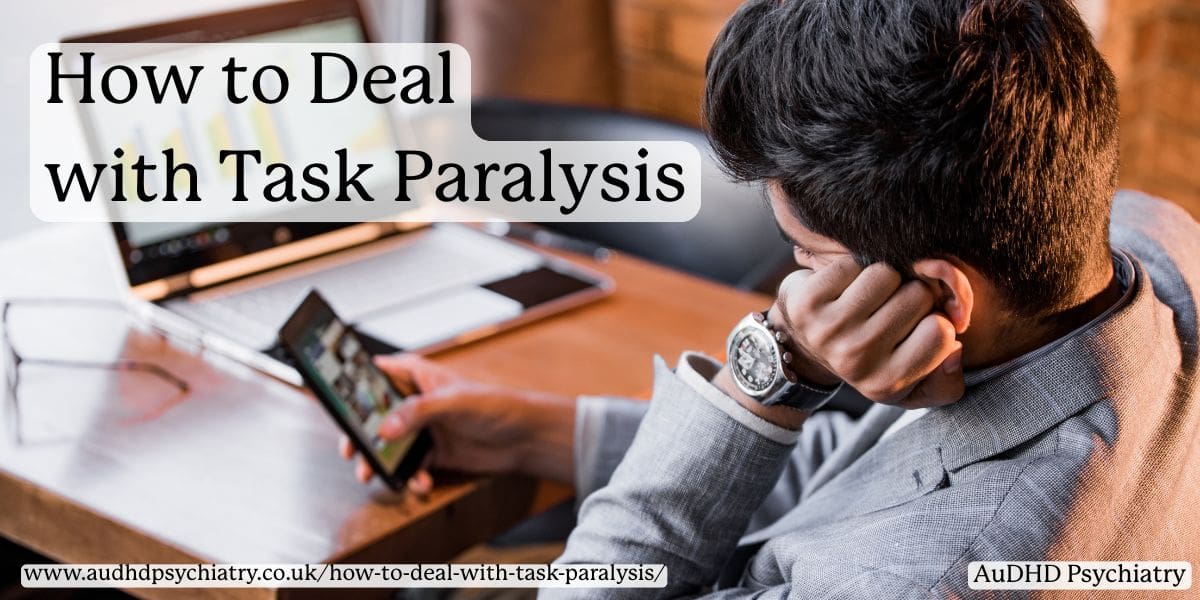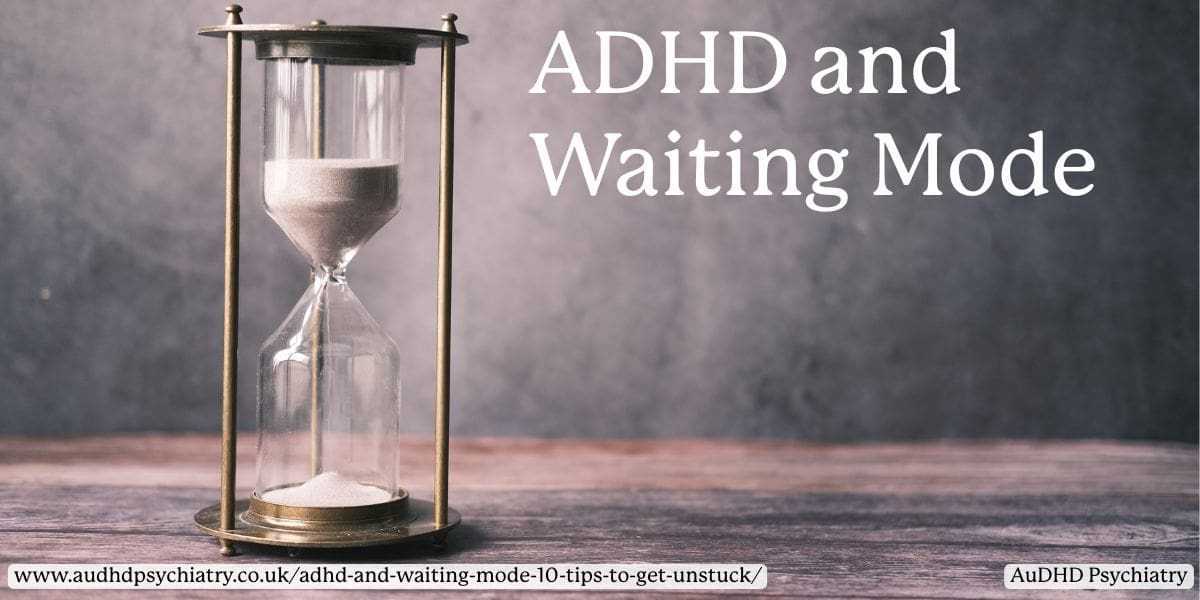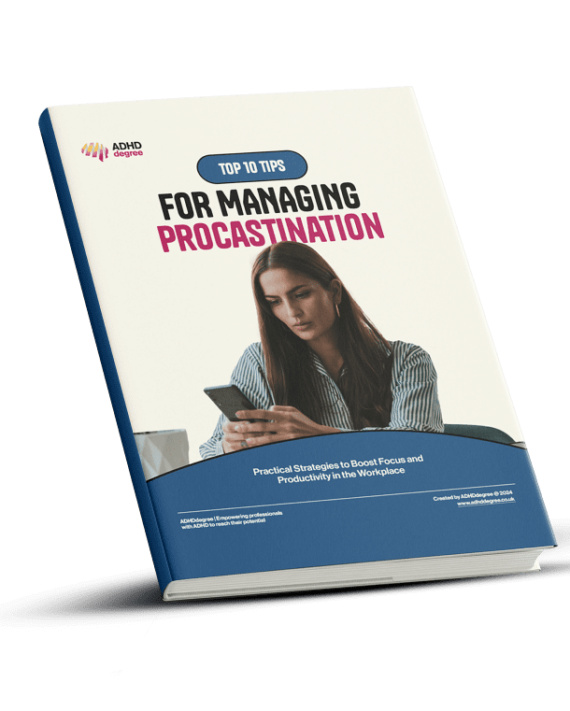You sit down to begin a simple task, such as replying to an email, loading the washing machine, or writing that first sentence, and nothing happens. Time slips by, and the task remains untouched. This experience, known as task paralysis, is more than a fleeting distraction. For many, it is a consistent and distressing barrier to completing everyday activities.
Task paralysis is not a reflection of laziness or poor discipline. It is a recognised manifestation of executive dysfunction, commonly seen in individuals with ADHD, anxiety, or perfectionist thinking. Your brain may understand what needs to be done, but it struggles to initiate action, often due to overwhelm, emotional resistance, or a fear of failure.
In this article, we explain how to identify the signs of ADHD task paralysis, understand its causes, and explore evidence-based strategies to overcome it. If you’re wondering whether ADHD might be part of the picture, take our screener test to learn more.
What Is Task Paralysis?
Task paralysis is the state of being mentally frozen when faced with a task, no matter how small. It’s more than procrastination; it’s a form of mental paralysis that often leaves individuals feeling incapable of starting, despite having the time or resources to do so. This experience can happen to anyone, but it is especially common among those with attention deficit hyperactivity disorder (ADHD), anxiety, or perfectionist tendencies.
Unlike procrastination, which is usually a choice to delay, task paralysis often occurs involuntarily. You may feel emotionally overwhelmed, cognitively overloaded, or physically incapable of initiating movement. For people with ADHD, this paralysis can be the result of executive dysfunction, which affects planning, prioritising, and starting tasks. Emotional dysregulation and time blindness can also worsen the experience.
Task paralysis often involves a cascade of internal conflict: the urge to act is met with a rising sense of dread or mental fog, followed by avoidance and self-criticism. Over time, this can create a vicious cycle, where fear of the task grows and confidence diminishes.
If you’ve ever thought, “Why can’t I start anything?” or “Why do small tasks feel impossible?”, you may be experiencing task initiation difficulties related to ADHD or anxiety. It’s important to recognise this pattern early and use compassionate strategies to interrupt it.
What Causes Task Paralysis?
Task paralysis can have several overlapping causes, most of which are rooted in the brain’s executive functioning system. Understanding what contributes to the freeze response can help in choosing the right strategies to overcome it.

Cognitive Overload and Emotional Stress
When the brain is overwhelmed with information or competing priorities, it can shut down as a stress response. This is particularly true for individuals dealing with ADHD, anxiety disorders, or depression, where dopamine levels and motivation are already impacted. The sheer volume of tasks can make even starting feel like too much.
Fear of Failure and Perfectionism
Some people freeze because they’re afraid of doing the task incorrectly. This fear of making the “wrong choice”, also known as choice paralysis, can stem from high personal standards or past criticism. This is especially relevant for young people and adults with ADHD, who often carry long-standing worries about underperformance.
ADHD and Executive Dysfunction
For those with ADHD, executive dysfunction is a leading cause of task paralysis. Key processes like organising thoughts, breaking down tasks, and transitioning between activities are often impaired. This makes initiating even mundane tasks significantly harder, especially without external prompts or structured support.
Screen Time and Task Avoidance
Modern triggers such as social media, notifications, or constant doomscrolling also play a role. Digital environments are designed to hijack focus, reinforcing avoidance behaviour and reducing the brain’s capacity to shift into goal-directed action. If you’re frequently stuck in a scroll cycle, see our article on ADHD and the digital age.
Recognising your own pattern of avoidance is the first step to breaking out of paralysis. Once the root cause is clear, it becomes easier to apply the right tools to move forward.
Symptoms of Task Paralysis
Task paralysis can manifest in subtle but debilitating ways, often mistaken for laziness or a lack of willpower. In reality, the symptoms stem from complex interactions between brain function, stress, and emotional regulation.
Emotional Symptoms
Many individuals experience feelings of shame, frustration, and guilt during or after task paralysis episodes. You might feel overwhelmed, anxious, or frozen by the pressure to complete a task, yet unable to begin, especially after an ADHD crash, where focus and emotional regulation plummet. This emotional freeze often feeds into a vicious cycle, reinforcing avoidance and self-doubt.
Cognitive and Physical Signs
Mentally, task paralysis feels like brain fog or an inability to prioritise what to do first. Thoughts can spiral, leaving you stuck on a single step or fearing the wrong choice. Physically, you might experience stillness or restlessness. The freeze response is often triggered by executive dysfunction, making even simple activities feel unmanageable.

Behavioural Symptoms
Common behaviours include:
- Scrolling aimlessly
- Repeatedly opening and closing apps or tabs
- Starting multiple tasks and finishing none
- Avoiding important or mundane tasks altogether
These symptoms frequently disrupt daily life, academic performance, or professional responsibilities. If you feel like you’re stuck doing nothing despite high motivation, that could be a sign of ADHD-related task initiation difficulty.
The Link Between ADHD and Task Paralysis
For people with ADHD, task paralysis is more than just a struggle. It’s often a chronic barrier. This link stems from the way ADHD affects the brain’s executive functioning, particularly around planning, prioritising, and starting tasks.
ADHD, Executive Dysfunction, and Freeze
The ADHD brain often struggles with working memory, task initiation, and time blindness. These challenges make it hard to predict how long a task will take, what order to do it in, or how to overcome the emotional wall before beginning. As a result, even seemingly “easy wins” can lead to mental shutdown.
Unlike typical procrastination, ADHD task paralysis often triggers a stress response that causes the individual to freeze rather than delay. This is compounded by rejection sensitivity, which can turn small mistakes into a source of overwhelming pressure.
Why “Just Start” Doesn’t Work
Advice like “just do it” or “start with five minutes” often fails for people with ADHD. Without the right dopamine cues or external structure, the brain simply doesn’t engage. That’s why support systems like ADHD coaching or structured routines are often more effective than willpower alone.
If this pattern sounds familiar, you may benefit from support targeted at executive dysfunction. Explore our guide to ADHD coaching and executive support to find the right strategy for your needs.
9 Strategies to Overcome Task Paralysis
There’s no single solution to task paralysis, but certain strategies consistently help individuals move from stuck to started. These tips are especially effective for people with ADHD, executive dysfunction, or chronic overwhelm.
The Daily Brain Dump
Start your day with a “brain dump”, writing out everything on your mind. This clears cognitive clutter and creates a safe space for your thoughts. Apps like Goblin Tools or analogue task paralysis planners can support this process.
Break Tasks into Tiny Steps
Instead of writing “finish report,” start with “open laptop” or “name document.” Breaking tasks into smaller pieces helps overcome mental paralysis and creates an early sense of achievement. Each microtask completed delivers a small dopamine boost, reinforcing progress. This method also helps you build task initiation momentum, which is especially valuable if you’re struggling with executive function.
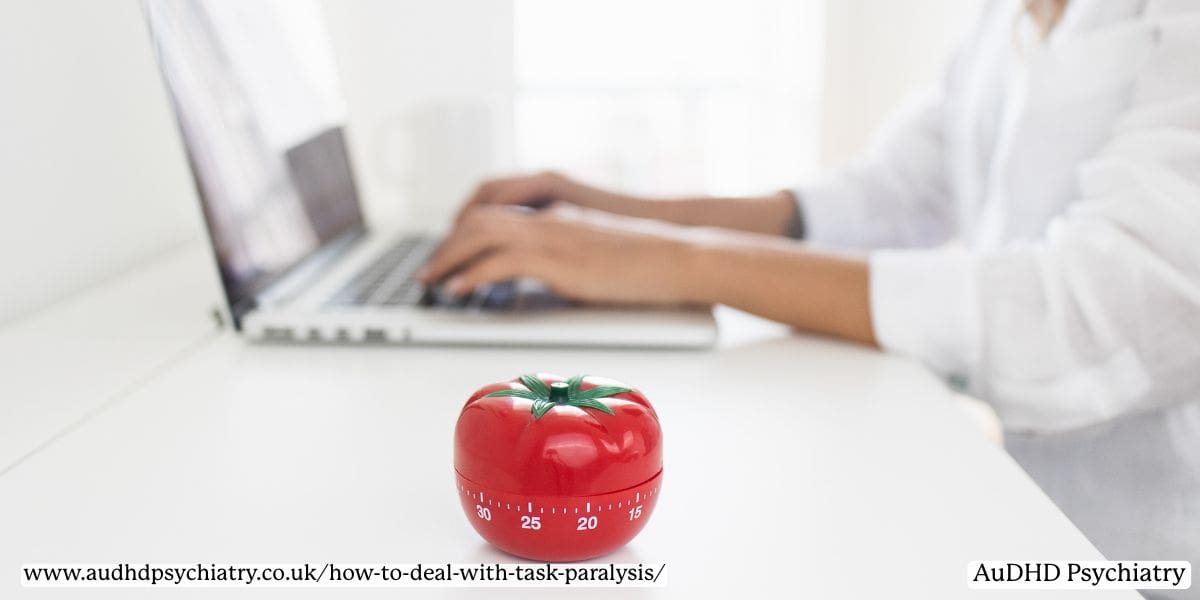
Use a Visual Timer or App
Visual timers (like the Pomodoro Technique) offer urgency without panic. Seeing time move can kickstart motivation while preventing time blindness, which is a common ADHD trait. Timer-based apps also allow you to set custom work sprints that align with your energy levels. This may be helpful since many individuals with ADHD find that working in short bursts of focus is more sustainable than long work sessions.
Prioritise 1–3 Tasks
Use SMART goals or highlight just 1–3 key tasks each day. Trying to do too much at once often fuels paralysis. You’ll also feel more satisfied checking off a few important wins than juggling a dozen unfinished tasks.
Make It More Stimulating
Your brain responds well to novelty, so find ways to make tasks feel more engaging. Add upbeat music, change your workspace, or turn the task into a challenge. Visual cues as simple as using colourful sticky notes or setting a “beat the clock” game can provide the dopamine you need to power through. These stimulation hacks are especially helpful for combating task freeze in the ADHD brain.
Add External Accountability
Sometimes, the best way to get started is to know someone else is watching. Co-working apps like Focusmate create real-time accountability by pairing you with another person also trying to focus. Support groups, coaches, or even text check-ins with a friend can provide structure and a sense of expectation. This strategy works because it shifts motivation from internal pressure to external commitment, which could be a helpful switch if you’re feeling isolated.
Celebrate Progress
Ticking off even the smallest task boosts dopamine levels. Try gamifying your routine or rewarding consistency over perfection. Celebrating reinforces positive behaviour, builds confidence, and helps counteract feelings of failure that often follow periods of paralysis.
Move to Reboot Focus
Physical movement can reboot your focus and regulate the nervous system. Whether it’s a brisk walk, a few jumping jacks, or stretching at your desk, exercise increases blood flow to the brain and reduces stress hormones. This makes it easier to transition back into task mode after freezing. Learn how movement supports focus and symptom regulation in our guide to exercise and ADHD.
Practice Self-Compassion
Don’t punish yourself for freezing. The best way to re-engage is with support, not shame. Self-kindness supports emotional regulation and builds long-term resilience. Acknowledge that struggling to complete tasks doesn’t mean you’re lazy or unmotivated. Show yourself the same patience you would offer a friend, and remind yourself that progress happens step by step.
It’s also advisable to speak with your provider for any treatment options that may be available to you. To discuss any treatment changes, it’s helpful to bring a record of what you’ve tried, or review an ADHD medication dosage chart with your doctor. Additionally, choosing ADHD medications with a suitable duration of action ensures your energy aligns with your daily demands, reducing ADHD freeze risk.
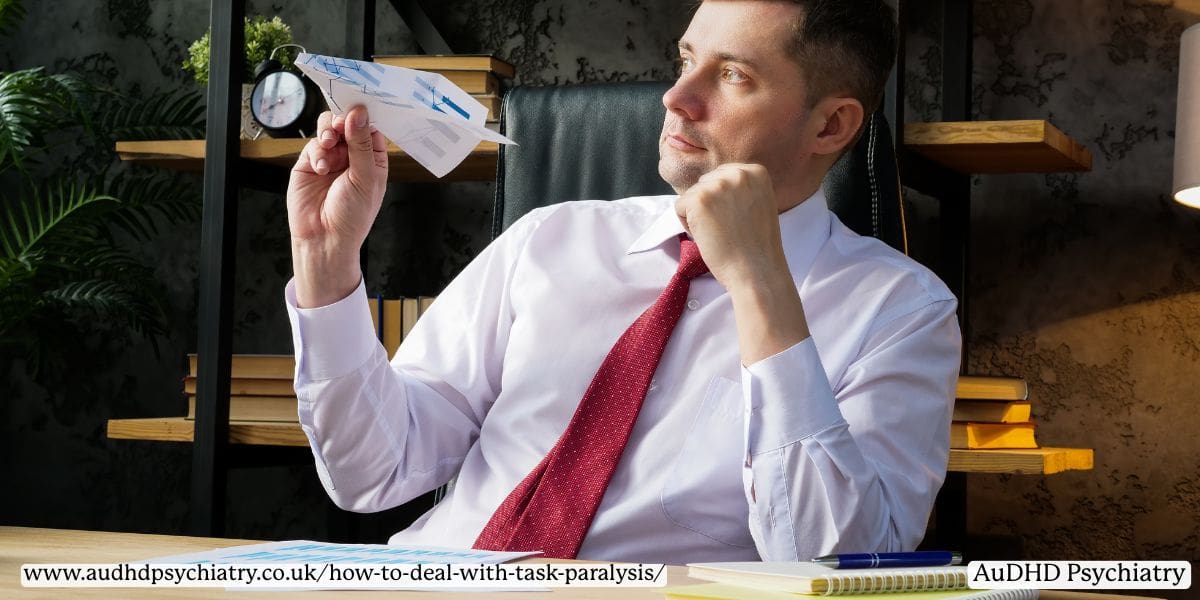
Task Paralysis vs. Procrastination
Though they may look similar on the surface, task paralysis and procrastination are driven by different psychological mechanisms. Knowing the difference can help you or your child respond more effectively when stuck.
Task Paralysis: A Freeze in Function
Task paralysis is often described as an involuntary freeze response. You want to act, but your brain cannot engage the starting mechanism. This form of mental shut-down is common in ADHD, executive dysfunction, and anxiety. It’s also closely related to emotional overwhelm, sensory overload, and the fear of underperforming. Individuals often experience physical stillness, looping thoughts, or intense guilt during these episodes.
Procrastination: A Deliberate Delay
Procrastination, in contrast, is usually a conscious decision to delay action. It might involve waiting for the “right time,” feeling unmotivated, or choosing more pleasurable distractions. While procrastination can also be harmful, it often lacks the internal panic or helplessness seen in task paralysis.
| Feature | Task Paralysis | Procrastination |
| Emotional Response | Anxiety, dread, overwhelm | Boredom, mild avoidance |
| Physical State | Freeze, stillness, looping thoughts | Intentional distractions |
| Executive Function | Impaired initiation | Preserved initiation |
| Common Triggers | ADHD, anxiety, perfectionism | Low motivation, task aversion |
| Level of Control | Involuntary | Voluntary |
Understanding this distinction can lead to more targeted support. For those experiencing task freeze, ADHD-informed strategies, resources, and tools that support task initiation and break emotional avoidance cycles will be more effective than standard productivity tips.
Task Paralysis vs. ADHD Paralysis
At first glance, task paralysis and ADHD paralysis may seem interchangeable, but they arise from slightly different internal experiences and neurological pathways. Understanding the distinction can help you choose the right support and strategies.
What Is ADHD Paralysis?
ADHD paralysis is a specific type of executive paralysis caused by overstimulation, poor prioritisation, and cognitive overload. It’s often described as feeling mentally frozen despite knowing what needs to be done. This state results from executive dysfunction, a hallmark of ADHD, and is commonly triggered by competing demands or emotionally charged tasks.
ADHD paralysis symptoms can include difficulty starting even small tasks, physical stillness, internal panic, and avoidance behaviours. These symptoms are involuntary and often misunderstood as laziness or disinterest. In reality, it’s the ADHD brain struggling with impaired task initiation and mental filtering.
How Task Paralysis Compares
Task paralysis can occur in anyone, but for individuals with ADHD, it’s frequently amplified into ADHD paralysis. While task paralysis is often situational and short-lived, ADHD paralysis is more persistent and deeply rooted in disrupted executive functioning. Factors like sensory overload, emotional dysregulation, and time blindness can make it harder to recover.
How to Overcome ADHD Paralysis
To get out of ADHD paralysis, you need more than just a to-do list. Break tasks into smaller pieces, reduce overstimulation, and use strategies like visual cues or accountability partners. Pomodoro timers and dopamine-neutral tasks (e.g., stretching or tidying) can help reboot the brain.
If you’re wondering how to overcome ADHD paralysis or searching for tools to support executive prioritization, structured routines and ADHD coaching may be the best next step. These methods work because they support both the neurological and behavioural aspects of ADHD, empowering you to regain momentum and start again.
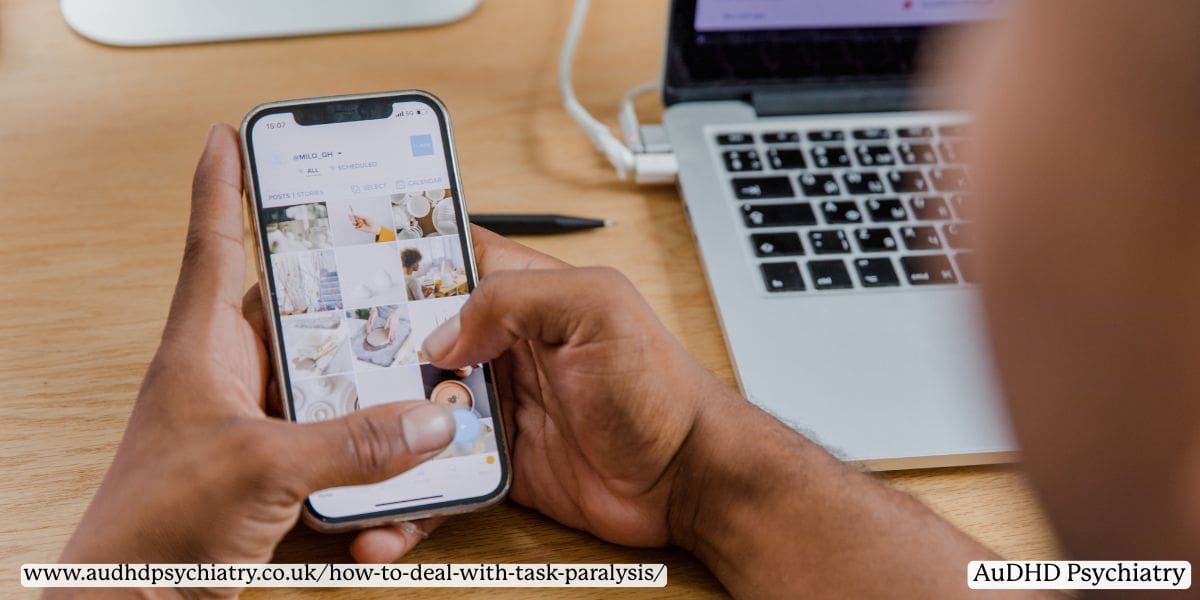
Task Paralysis and Scrolling
For many people with ADHD, task paralysis and screen use go hand in hand. Social media and scrolling apps are designed to capture your attention, but they can also overwhelm your brain’s executive function, making it harder to start or return to tasks.
Why Scrolling Triggers a Freeze
Endless scrolling provides short bursts of dopamine, but it also floods your brain with stimulation. For ADHD brains already coping with executive dysfunction and emotional dysregulation, this can lead to a mental or ADHD shutdown. The sheer volume of information leaves you overstimulated, distracted, and unable to act.
ADHD and Scrolling Paralysis
ADHD brains are often drawn to novelty and immediate rewards. That’s why social media platforms can become the default escape when you’re overwhelmed. But this escape can become a trap. The longer you scroll, the harder it becomes to break free, reinforcing ADHD scrolling paralysis. You may recognise this cycle as “just one more video” turning into hours of inaction.
Healthy Screen Habits That Support Focus
To break the pattern, consider dopamine-neutral replacements: a five-minute walk, stretching, or switching to a podcast without visuals. Use screen-limiting tools like Forest or One Sec to interrupt automatic scrolling habits. Replacing the scroll with short tasks, like writing one line of your to-do list, can reset your momentum without overloading your brain.
How to Prevent Task Paralysis Before It Starts
While it’s possible to work through task paralysis once it hits, prevention is often more effective. Setting up your day to minimise overwhelm makes it easier to stay focused and productive.
Establishing a Routine That Reduces Freeze
Creating a consistent morning routine helps reduce decision-making fatigue. Try starting with a short planning ritual: review your calendar, highlight 1–3 key tasks, and visualise how you’ll complete them. Time blocking can also help structure your day into manageable chunks, especially for individuals with poor time management or executive functioning challenges. If you’re trying to manage task paralysis in the workplace, see this article for more support.
Environmental Cues That Nudge Action
Use visual reminders to guide your day: sticky notes, alarms, or a task board can act as gentle nudges. Keeping your workspace free from clutter and using a dedicated “focus zone” can minimise distractions and help your brain associate certain areas with getting things done.
Build Your Own Anti-Freeze Checklist
For tasks you freeze on regularly, for example, starting a report or prepping dinner, write a step-by-step checklist when you’re calm. This becomes your go-to script when your brain shuts down. Include achievable, smaller steps, like “open laptop” or “get ingredients out.” These reduce mental paralysis and restore task initiation.
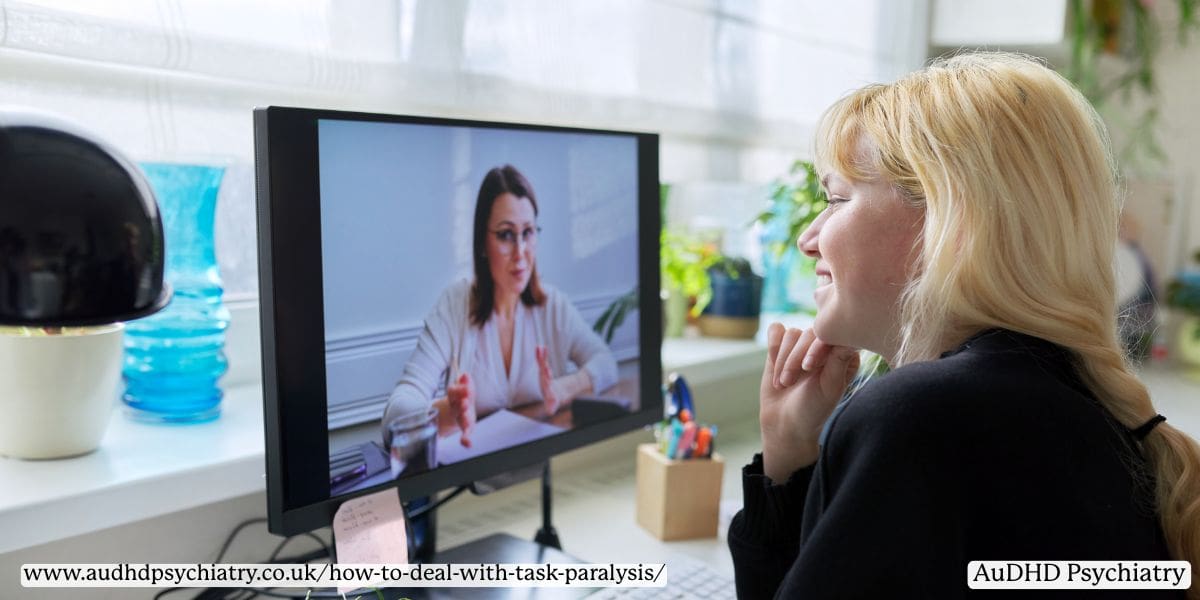
When to Get Help for Task Paralysis
Sometimes, no matter how many strategies you try, you can still experience task paralysis. When this happens often, it may be time to seek professional help, especially if the paralysis is affecting your mental health, relationships, or ability to complete everyday tasks.
Signs You Might Need Extra Support
If you experience daily shutdowns, overwhelming feelings of guilt, or persistent executive dysfunction, support from a therapist, ADHD coach, or occupational therapist can make a meaningful difference. Symptoms like emotional dysregulation, sleep disturbances, or worsening mental health may signal that task paralysis is part of a larger pattern.
What an ADHD Coach or Therapist Can Offer
Professional support helps you personalise strategies and understand the root of your paralysis. ADHD coaches provide tools for task initiation, breaking goals into smaller parts, and building consistent routines. Therapists, especially those trained in CBT, can help address fear of failure, perfectionism, or underlying anxiety that fuels avoidance.
It’s Not “Just Laziness”
Task paralysis is not a character flaw. It’s a neurological response to overwhelm. Seeking help doesn’t mean you’ve failed; you’re ready for a more personalised and sustainable approach. If you need support, explore our recommended ADHD platforms and coaching resources to get started with personalised help.
How to Deal with Task Paralysis: Conclusion
Feeling mentally frozen in front of a to-do list isn’t a personal failure. It’s a real experience tied to executive dysfunction, emotional dysregulation, and patterns seen in adult ADHD. Whether you’re struggling with choice paralysis, mental paralysis, or simply no motivation to do anything, these are signs your brain may be overwhelmed by more than the task itself.
The good news is you don’t have to figure it out alone. With the right strategies, like breaking tasks down, using visual cues, and introducing structured routines, you can complete specific tasks and rebuild trust in your own ability to start and finish.
If you’re stuck in a cycle of frustration, distraction, and avoidance, it may be time to explore your ADHD symptoms more deeply. A formal assessment can open the door to personalised treatment, coaching, and tools that actually work for your brain. Book a private ADHD assessment today and take the first step toward clarity, confidence, and control.

